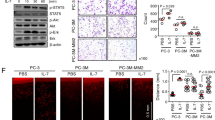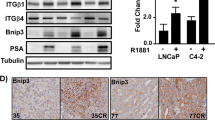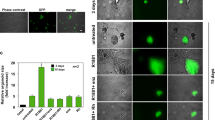Abstract
Interleukin-8 (IL-8), a chemokine implicated in the metastasis and angiogenesis of a variety of cancers, has been reported to be overexpressed in prostate cancer. In this study, we ascribe a new role for IL-8 in prostate cancer progression using LNCaP cells. We demonstrate that IL-8 activates the androgen receptor and confers androgen-independent growth, while serving as a potent chemotactic factor. Our evaluation of the possible signal pathways involved in androgen-independence and cell migration shows that the tyrosine kinases Src and FAK (focal adhesion kinase) are involved in IL-8-induced signaling. Pharmacological and genetic inhibitors of Src and FAK interfere with IL-8-induced cell migration, while only the Src inhibitor was able to repress androgen-independent growth. This suggests that both growth and migration depend on the activity of Src, whereas cell migration also requires the activation of FAK. Our evidence that IL-8-induced androgen-independent growth is, at least in part, due to androgen receptor activation includes (1) an inhibitor of androgen receptor activity diminishes cell growth; (2) androgen receptor transactivation potential is augmented by IL-8 and (3) androgen receptor is recruited to the promoter of prostate specific antigen (PSA) upon IL-8 treatment, based on chromatin immunoprecipitation experiments. Taken together, our data suggest that in addition to its role in metastasis and angiogenesis, IL-8 may also serve as a facilitator for androgen-independent transition of prostate cancers. To our knowledge, this is the first report about the tyrosine kinase signals and androgen receptor activation induced by IL-8 in prostate cancer cells. The observation that IL-8 mediates its growth and chemotactic effects via Src and FAK suggests the potential use for tyrosine kinase inhibitors at early stage of prostate cancer development.
This is a preview of subscription content, access via your institution
Access options





Similar content being viewed by others
References
Balbay MD, Pettaway CA, Kuniyasu H, Inoue K, Ramirez E, Li E, Fidler IJ and Dinney CP . (1999). Clin. Cancer Res., 5, 783–789.
Barlic J, Andrews JD, Kelvin AA, Bosinger SE, DeVries ME, Xu L, Dobransky T, Feldman RD, Ferguson SS and Kelvin DJ . (2000). Nat. Immunol., 1, 227–233.
Cary LA, Han DC, Polte TR, Hanks SK and Guan JL . (1998). J. Cell Biol., 140, 211–221.
Chen HC and Guan JL . (1994). Proc. Natl. Acad. Sci., USA, 91, 10148–10152.
Chen T, Wang LH and Farrar WL . (2000). Cancer Res., 60, 2132–2135.
Craft N, Shostak Y, Carey M and Sawyers CL . (1999). Nat. Med., 5, 280–285.
Culig Z, Hobisch A, Cronauer MV, Radmayr C, Trapman J, Hittmair A, Bartsch G and Klocker H . (1994). Cancer Res., 54, 5474–5478.
Dai J, Shen R, Sumitomo M, Stahl R, Navarro D, MC G and Nanus DM . (2002). Clin. Cancer Res., 8, 2399–2405.
Debes JD, Schmidt LJ, Huang H and Tindall DJ . (2002). Cancer Res., 62, 5632–5636.
Feniger-Barish R, Yron I, Meshel T, Matityahu E and Ben-Baruch A . (2003). Biochemistry, 42, 2874–2886.
Ferrer FA, Miller LJ, Andrawis RI, Kurtzman SH, Albertsen PC, Laudone VP and Kreutzer DL . (1998). Urology, 51, 161–167.
Font de Mora J and Brown M . (2000). Mol. Cell. Biol., 20, 5041–5047.
Gioeli D, Ficarro SB, Kwiek JJ, Aaronson D, Hancock M, Catling AD, White FM, Christian RE, Settlage RE, Shabanowitz J, Hunt DF and Weber MJ . (2002). J. Biol. Chem., 277, 29304–29314.
Greene GF, Kitadai Y, Pettaway CA, von Eschenbach AC, Bucana CD and Fidler IJ . (1997). Am. J. Pathol., 150, 1571–1582.
Hunger-Glaser I, Salazar EP, Sinnett-Smith J and Rozengurt E . (2003). J. Biolog. Chem., 278, 22631–22643.
Inoue K, Slaton JW, Eve BY, Kim SJ, Perrotte P, Balbay MD, Yano S, Bar-Eli M, Radinsky R, Pettaway CA and Dinney CP . (2000). Clin. Cancer Res., 6, 2104–2119.
Kanda N and Watanabe S . (2001). J. Investig. Dermatol., 117, 274–283.
Lee LF, Guan J, Qiu Y and Kung HJ . (2001). Mol. Cell. Biol., 21, 8385–8397.
Lee SO, Lou W, Hou M, de Miguel F, Gerber L and Gao AC . (2003). Clin. Cancer Res., 9, 370–376.
Lin HK, Yeh S, Kang HY and Chang C . (2001). Proc. Natl. Acad. Sci. USA, 98, 7200–7205.
Louie MC, Yang HQ, Ma AH, Xu W, Zou JX, Kung HJ and Chen HW . (2003). Proc. Natl. Acad. Sci., USA, 100, 2226–2230.
Luttrell LM and Lefkowitz RJ . (2002). J. Cell Sci., 115, 455–465.
Ma YC, Huang J, Ali S, Lowry W and Huang XY . (2000). Cell, 102, 635–646.
Matsushima K, Baldwin ET and Mukaida N . (1992). Chem. Immunol., 51, 236–265.
Migliaccio A, Castoria G, Di Domenico M, de Falco A, Bilancio A, Lombardi M, Barone MV, Ametrano D, Zannini MS, Abbondanza C and Auricchio F . (2000). EMBO J., 19, 5406–5417.
Miller MC, Zhao G, Ng A, Marley GM, Wright Jr GL, Vessella RL, Ralph D and Veltri RW . (1999). Urology, 53, 139–147.
Moore BB, Arenberg DA, Stoy K, Morgan T, Addison CL, Morris SB, Glass M, Wilke C, Xue YY, Sitterding S, Kunkel SL, Burdick MD and Strieter RM . (1999). Am. J. Pathol., 162, 5511–5518.
Onuffer JJ and Horuk R . (2002). Trends Pharmacolog. Sci., 23, 459–467.
Papakonstanti EA, Kampa M, Castanas E and Stournaras C . (2003). Mol. Endocrinol., 17, 870–881.
Parsons JT, Martin KH, Slack JK, Taylor JM, Weed SA and Shattil SJ . (2000). Oncogene, 19, 5606–5613.
Patel BJ, Pantuck AJ, Zisman A, Tsui KH, Paik SH, Gitlitz B, Caliliw R, Sheriff S, Wu L, deKernion J, Tsao CL and Belldegrun AS . (2000). J. Urol., 164, 1420–1425.
Prenzel N, Zwick E, Daub H, Leserer M, Abraham R, Wallasch C and Ullrich A . (1999). Nature, 402, 884–888.
Qiu Y, Ravi L and Kung HJ . (1998). Nature, 393, 83–85.
Reiland J, Furcht LT and McCarthy JB . (1999). Prostate, 41, 78–88.
Robinson D, He F, Pretlow T and Kung HJ . (1996). Proc. Natl. Acad. Sci., USA, 93, 5958–5962.
Salazar EP and Rozengurt E . (1999). J. Biolog. Chem., 274, 28371–28378.
Schadendorf D, Moller A, Algermissen B, Worm M, Sticherling M and Czarnetzki BM . (1993). J. Immunol., 151, 2667–2675.
Shi Y, Brands FH, Chatterjee S, Feng AC, Groshen S, Schewe J, Lieskovsky G and Cote RJ . (2001). J. Urol., 166, 1514–1519.
Sieg DJ, Hauck CR and Schlaepfer DD . (1999). J. Cell Sci., 112, 2677–2691.
Slack JK, Adams RB, Rovin JD, Bissonette EA, Stoker CE and Parsons JT . (2001). Oncogene, 20, 1152–1163.
Sumitomo M, Shen R, Walburg M, Dai J, Geng Y, Navarro D, Boileau G, Papandreou CN, Giancotti FG, Knudsen B and Nanus DB . (2000). J. Clin. Investig., 106, 1399–1407.
Tremblay L, Hauck W, Aprikian AG, Begin LR, Chapdelaine A and Chevalier S . (1996). Int. J. Cancer, 68, 164–171.
Torring N, Jorgensen PE, Sorensen BS and Nexo E . (2000). Anticancer Res., 20, 91–95.
Ueda T, Mawji NR, Bruchovsky N and Sadar MD . (2002). J. Biolog. Chem., 277, 38087–38094.
Veltri RW, Miller MC, Zhao G, Ng A, Marley GM, Wright Jr GL, Vessella RL and Ralph D . (1999). Urology, 53, 139–147.
Venkatakrishnan G, Salgia R and Groopman JE . (2000). J. Biolog. Chem., 275, 6868–6875.
Wen Y, Hu MC, Makino K, Spohn B, Bartholomeusz G, Yan DH and Hung MC . (2000). Cancer Res., 60, 6841–6845.
Xia L, Robinson D, Ma AH, Chen HC, Wu F, Qiu Y and Kung HJ . (2002). J. Biolog. Chem., 277, 35422–35433.
Xiao D, Qu X and Weber H . (2003). Cell Signal, 15, 945–953.
Xie K, Fidler IJ and Herrera CA . (1998). Human Gene Ther., 9, 2699–2708.
Xu L, Bucana CD, Silva el VG, Hess KR, Gershenson DM and Fidler IJ . (2002). Int. J. Oncol., 20, 5–13.
Yang L, Wang L, Lin HK, Kan PY, Xie S, Tsai MY, Wang PH, Chen YT and Chang C . (2003). Biochem. Biophys. Res. Commun., 305, 462–469.
Yeh S, Lin HK, Kang HY, Thin TH, Lin MF and Chang C . (1999). Proc. Natl. Acad. Sci., USA, 96, 5458–5463.
Acknowledgements
The work was supported by NIH grants (CA39207, DK52695, CA 57179 and CA82073 to H J K, K08 DK60748 to CPE and P30 CA93373 to UC Davis Cancer Center) and DOD DAMD 17-02-1-0020 to HJK. L.F. L. acknowledges the support of a DOD prostate cancer postdoctoral fellowship, and ML is supported by an NIH MCB training grant to UC Davis.
Author information
Authors and Affiliations
Corresponding author
Rights and permissions
About this article
Cite this article
Lee, LF., Louie, M., Desai, S. et al. Interleukin-8 confers androgen-independent growth and migration of LNCaP: differential effects of tyrosine kinases Src and FAK. Oncogene 23, 2197–2205 (2004). https://doi.org/10.1038/sj.onc.1207344
Received:
Revised:
Accepted:
Published:
Issue Date:
DOI: https://doi.org/10.1038/sj.onc.1207344
Keywords
This article is cited by
-
Dura promotes metastatic potential in prostate cancer through the CXCR2 pathway
Journal of Neuro-Oncology (2021)
-
YES1 amplification confers trastuzumab–emtansine (T-DM1) resistance in HER2-positive cancer
British Journal of Cancer (2020)
-
Inotilone from Inonotus linteus suppresses lung cancer metastasis in vitro and in vivo through ROS-mediated PI3K/AKT/MAPK signaling pathways
Scientific Reports (2019)
-
Reawakening of dormant estrogen-dependent human breast cancer cells by bone marrow stroma secretory senescence
Cell Communication and Signaling (2018)
-
The prohibitin-repressive interaction with E2F1 is rapidly inhibited by androgen signalling in prostate cancer cells
Oncogenesis (2017)



